Leadership and Management Roles and Theories in Coca-Cola Operations
VerifiedAdded on 2021/02/22
|19
|4413
|366
Report
AI Summary
This report provides a comprehensive analysis of the roles of leaders and managers within Coca-Cola, examining their differences and applications in various situational contexts. It explores the key functions of management, including planning, organizing, directing, and controlling, and contrasts them with the essential qualities of leadership, such as setting goals, initiating action, and fostering coordination. The report delves into different leadership theories, including situational, systems, contingency, trait, and behavioral theories, and discusses their relevance in the context of Coca-Cola's operations. Furthermore, it explains key approaches to operations management, the principles of Total Quality Management (TQM), and how these principles apply to Coca-Cola, emphasizing the importance of customer focus, employee involvement, and continuous improvement. The report also identifies various factors impacting operational management and the decision-making process within Coca-Cola.
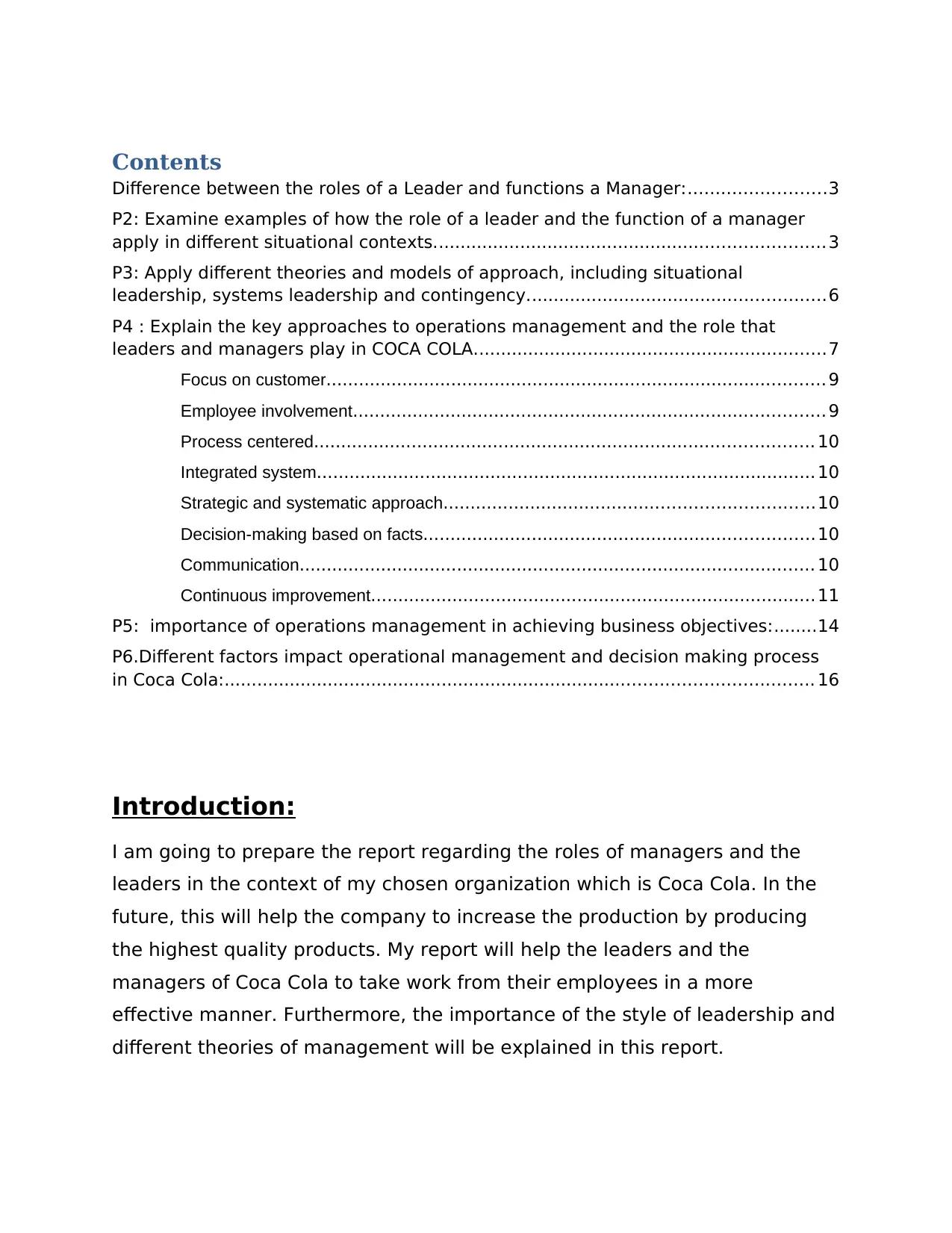
Contents
Difference between the roles of a Leader and functions a Manager:.........................3
P2: Examine examples of how the role of a leader and the function of a manager
apply in different situational contexts........................................................................3
P3: Apply different theories and models of approach, including situational
leadership, systems leadership and contingency.......................................................6
P4 : Explain the key approaches to operations management and the role that
leaders and managers play in COCA COLA.................................................................7
Focus on customer............................................................................................ 9
Employee involvement....................................................................................... 9
Process centered............................................................................................ 10
Integrated system............................................................................................ 10
Strategic and systematic approach....................................................................10
Decision-making based on facts........................................................................10
Communication............................................................................................... 10
Continuous improvement.................................................................................. 11
P5: importance of operations management in achieving business objectives:........14
P6.Different factors impact operational management and decision making process
in Coca Cola:............................................................................................................ 16
Introduction:
I am going to prepare the report regarding the roles of managers and the
leaders in the context of my chosen organization which is Coca Cola. In the
future, this will help the company to increase the production by producing
the highest quality products. My report will help the leaders and the
managers of Coca Cola to take work from their employees in a more
effective manner. Furthermore, the importance of the style of leadership and
different theories of management will be explained in this report.
Difference between the roles of a Leader and functions a Manager:.........................3
P2: Examine examples of how the role of a leader and the function of a manager
apply in different situational contexts........................................................................3
P3: Apply different theories and models of approach, including situational
leadership, systems leadership and contingency.......................................................6
P4 : Explain the key approaches to operations management and the role that
leaders and managers play in COCA COLA.................................................................7
Focus on customer............................................................................................ 9
Employee involvement....................................................................................... 9
Process centered............................................................................................ 10
Integrated system............................................................................................ 10
Strategic and systematic approach....................................................................10
Decision-making based on facts........................................................................10
Communication............................................................................................... 10
Continuous improvement.................................................................................. 11
P5: importance of operations management in achieving business objectives:........14
P6.Different factors impact operational management and decision making process
in Coca Cola:............................................................................................................ 16
Introduction:
I am going to prepare the report regarding the roles of managers and the
leaders in the context of my chosen organization which is Coca Cola. In the
future, this will help the company to increase the production by producing
the highest quality products. My report will help the leaders and the
managers of Coca Cola to take work from their employees in a more
effective manner. Furthermore, the importance of the style of leadership and
different theories of management will be explained in this report.
Paraphrase This Document
Need a fresh take? Get an instant paraphrase of this document with our AI Paraphraser
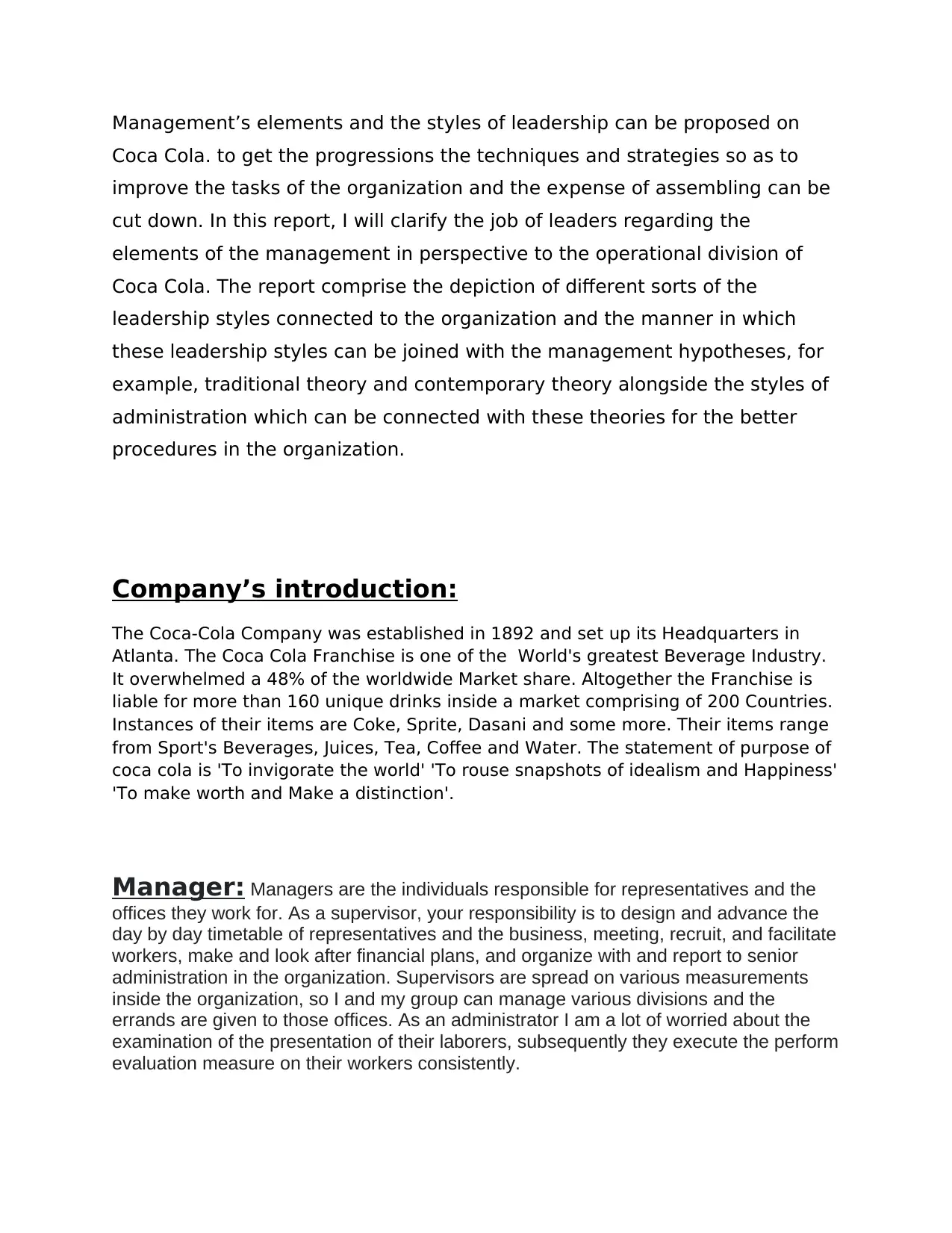
Management’s elements and the styles of leadership can be proposed on
Coca Cola. to get the progressions the techniques and strategies so as to
improve the tasks of the organization and the expense of assembling can be
cut down. In this report, I will clarify the job of leaders regarding the
elements of the management in perspective to the operational division of
Coca Cola. The report comprise the depiction of different sorts of the
leadership styles connected to the organization and the manner in which
these leadership styles can be joined with the management hypotheses, for
example, traditional theory and contemporary theory alongside the styles of
administration which can be connected with these theories for the better
procedures in the organization.
Company’s introduction:
The Coca-Cola Company was established in 1892 and set up its Headquarters in
Atlanta. The Coca Cola Franchise is one of the World's greatest Beverage Industry.
It overwhelmed a 48% of the worldwide Market share. Altogether the Franchise is
liable for more than 160 unique drinks inside a market comprising of 200 Countries.
Instances of their items are Coke, Sprite, Dasani and some more. Their items range
from Sport's Beverages, Juices, Tea, Coffee and Water. The statement of purpose of
coca cola is 'To invigorate the world' 'To rouse snapshots of idealism and Happiness'
'To make worth and Make a distinction'.
Manager: Managers are the individuals responsible for representatives and the
offices they work for. As a supervisor, your responsibility is to design and advance the
day by day timetable of representatives and the business, meeting, recruit, and facilitate
workers, make and look after financial plans, and organize with and report to senior
administration in the organization. Supervisors are spread on various measurements
inside the organization, so I and my group can manage various divisions and the
errands are given to those offices. As an administrator I am a lot of worried about the
examination of the presentation of their laborers, subsequently they execute the perform
evaluation measure on their workers consistently.
Coca Cola. to get the progressions the techniques and strategies so as to
improve the tasks of the organization and the expense of assembling can be
cut down. In this report, I will clarify the job of leaders regarding the
elements of the management in perspective to the operational division of
Coca Cola. The report comprise the depiction of different sorts of the
leadership styles connected to the organization and the manner in which
these leadership styles can be joined with the management hypotheses, for
example, traditional theory and contemporary theory alongside the styles of
administration which can be connected with these theories for the better
procedures in the organization.
Company’s introduction:
The Coca-Cola Company was established in 1892 and set up its Headquarters in
Atlanta. The Coca Cola Franchise is one of the World's greatest Beverage Industry.
It overwhelmed a 48% of the worldwide Market share. Altogether the Franchise is
liable for more than 160 unique drinks inside a market comprising of 200 Countries.
Instances of their items are Coke, Sprite, Dasani and some more. Their items range
from Sport's Beverages, Juices, Tea, Coffee and Water. The statement of purpose of
coca cola is 'To invigorate the world' 'To rouse snapshots of idealism and Happiness'
'To make worth and Make a distinction'.
Manager: Managers are the individuals responsible for representatives and the
offices they work for. As a supervisor, your responsibility is to design and advance the
day by day timetable of representatives and the business, meeting, recruit, and facilitate
workers, make and look after financial plans, and organize with and report to senior
administration in the organization. Supervisors are spread on various measurements
inside the organization, so I and my group can manage various divisions and the
errands are given to those offices. As an administrator I am a lot of worried about the
examination of the presentation of their laborers, subsequently they execute the perform
evaluation measure on their workers consistently.
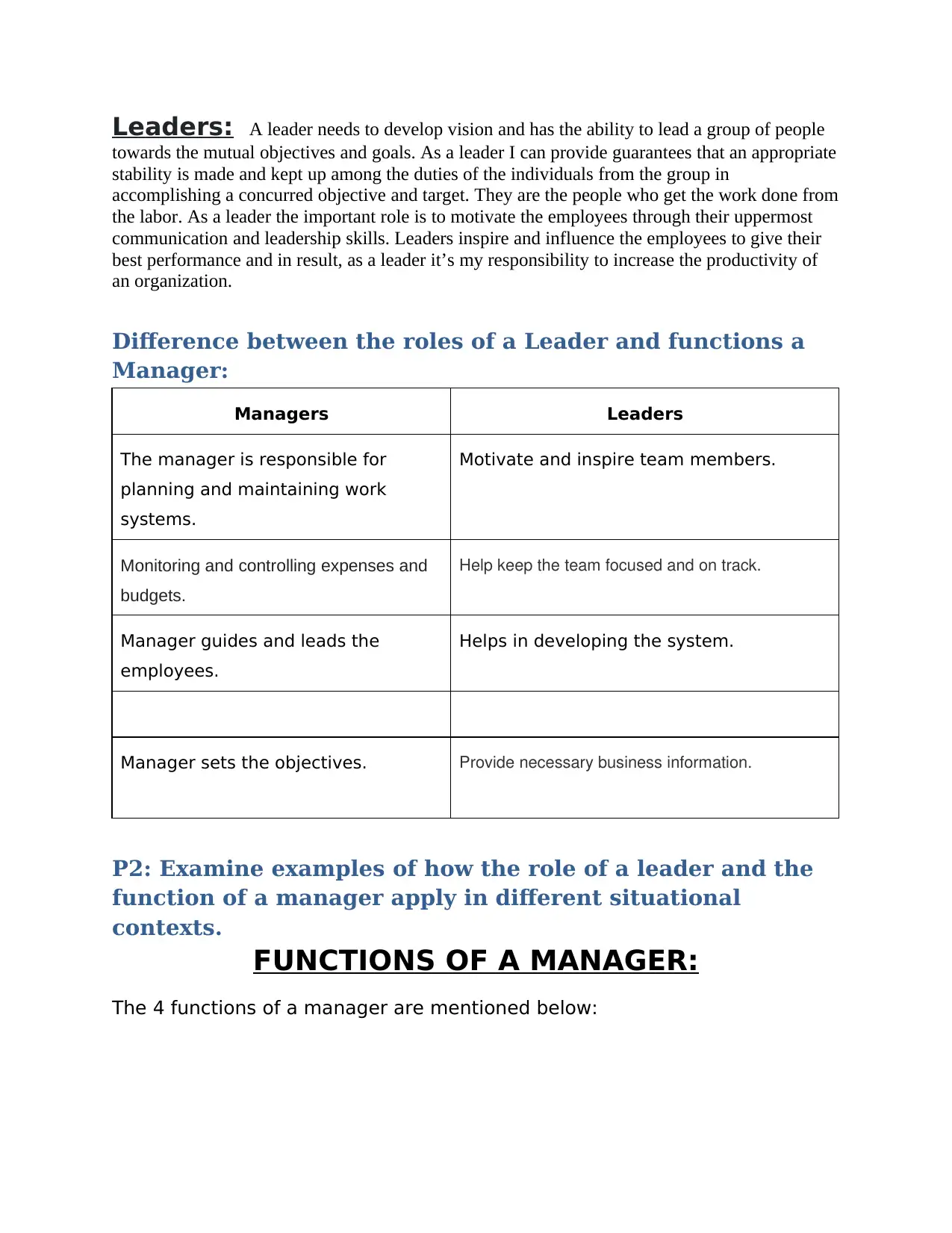
Leaders: A leader needs to develop vision and has the ability to lead a group of people
towards the mutual objectives and goals. As a leader I can provide guarantees that an appropriate
stability is made and kept up among the duties of the individuals from the group in
accomplishing a concurred objective and target. They are the people who get the work done from
the labor. As a leader the important role is to motivate the employees through their uppermost
communication and leadership skills. Leaders inspire and influence the employees to give their
best performance and in result, as a leader it’s my responsibility to increase the productivity of
an organization.
Difference between the roles of a Leader and functions a
Manager:
Managers Leaders
The manager is responsible for
planning and maintaining work
systems.
Motivate and inspire team members.
Monitoring and controlling expenses and
budgets.
Help keep the team focused and on track.
Manager guides and leads the
employees.
Helps in developing the system.
Manager sets the objectives. Provide necessary business information.
P2: Examine examples of how the role of a leader and the
function of a manager apply in different situational
contexts.
FUNCTIONS OF A MANAGER:
The 4 functions of a manager are mentioned below:
towards the mutual objectives and goals. As a leader I can provide guarantees that an appropriate
stability is made and kept up among the duties of the individuals from the group in
accomplishing a concurred objective and target. They are the people who get the work done from
the labor. As a leader the important role is to motivate the employees through their uppermost
communication and leadership skills. Leaders inspire and influence the employees to give their
best performance and in result, as a leader it’s my responsibility to increase the productivity of
an organization.
Difference between the roles of a Leader and functions a
Manager:
Managers Leaders
The manager is responsible for
planning and maintaining work
systems.
Motivate and inspire team members.
Monitoring and controlling expenses and
budgets.
Help keep the team focused and on track.
Manager guides and leads the
employees.
Helps in developing the system.
Manager sets the objectives. Provide necessary business information.
P2: Examine examples of how the role of a leader and the
function of a manager apply in different situational
contexts.
FUNCTIONS OF A MANAGER:
The 4 functions of a manager are mentioned below:
⊘ This is a preview!⊘
Do you want full access?
Subscribe today to unlock all pages.

Trusted by 1+ million students worldwide
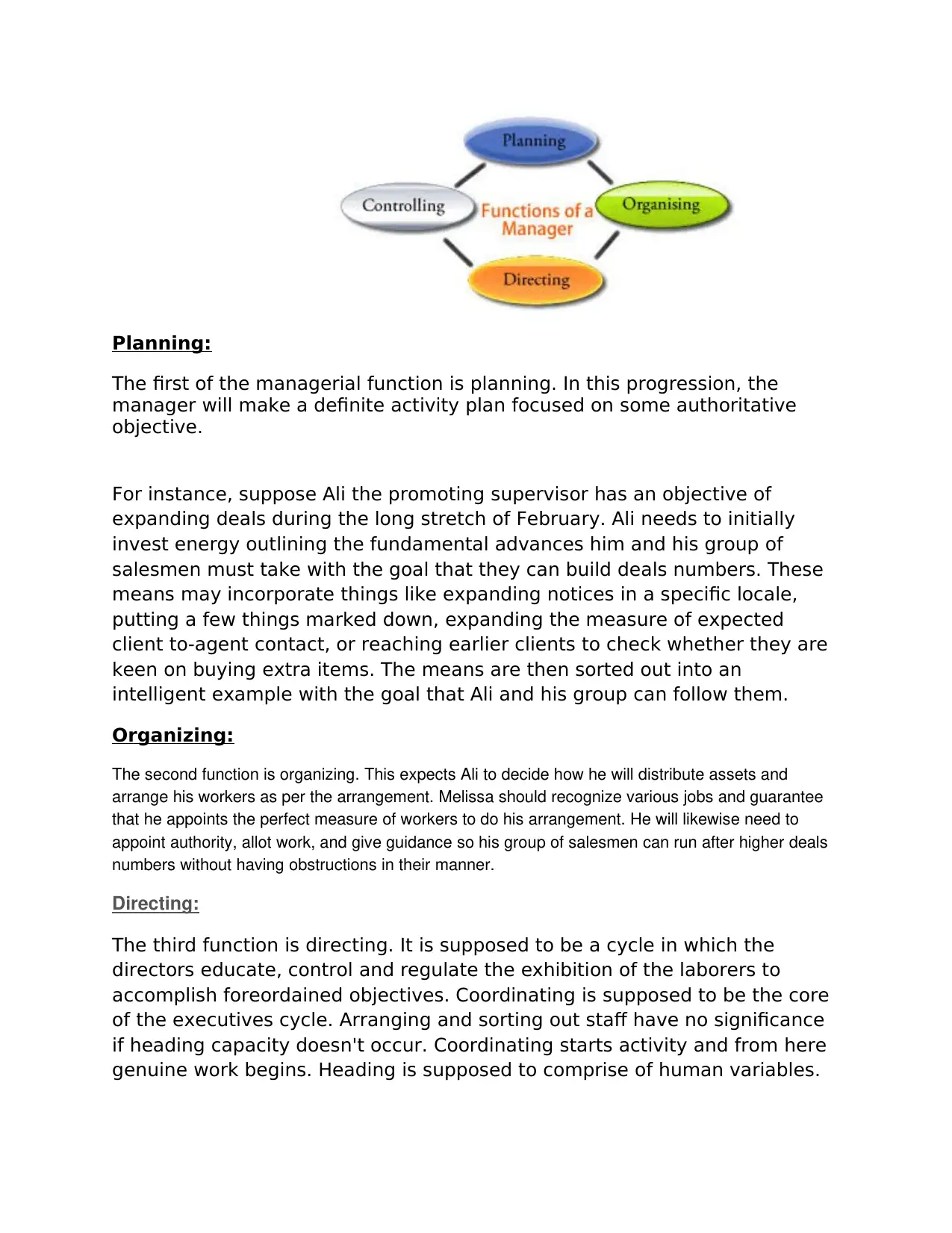
Planning:
The first of the managerial function is planning. In this progression, the
manager will make a definite activity plan focused on some authoritative
objective.
For instance, suppose Ali the promoting supervisor has an objective of
expanding deals during the long stretch of February. Ali needs to initially
invest energy outlining the fundamental advances him and his group of
salesmen must take with the goal that they can build deals numbers. These
means may incorporate things like expanding notices in a specific locale,
putting a few things marked down, expanding the measure of expected
client to-agent contact, or reaching earlier clients to check whether they are
keen on buying extra items. The means are then sorted out into an
intelligent example with the goal that Ali and his group can follow them.
Organizing:
The second function is organizing. This expects Ali to decide how he will distribute assets and
arrange his workers as per the arrangement. Melissa should recognize various jobs and guarantee
that he appoints the perfect measure of workers to do his arrangement. He will likewise need to
appoint authority, allot work, and give guidance so his group of salesmen can run after higher deals
numbers without having obstructions in their manner.
Directing:
The third function is directing. It is supposed to be a cycle in which the
directors educate, control and regulate the exhibition of the laborers to
accomplish foreordained objectives. Coordinating is supposed to be the core
of the executives cycle. Arranging and sorting out staff have no significance
if heading capacity doesn't occur. Coordinating starts activity and from here
genuine work begins. Heading is supposed to comprise of human variables.
The first of the managerial function is planning. In this progression, the
manager will make a definite activity plan focused on some authoritative
objective.
For instance, suppose Ali the promoting supervisor has an objective of
expanding deals during the long stretch of February. Ali needs to initially
invest energy outlining the fundamental advances him and his group of
salesmen must take with the goal that they can build deals numbers. These
means may incorporate things like expanding notices in a specific locale,
putting a few things marked down, expanding the measure of expected
client to-agent contact, or reaching earlier clients to check whether they are
keen on buying extra items. The means are then sorted out into an
intelligent example with the goal that Ali and his group can follow them.
Organizing:
The second function is organizing. This expects Ali to decide how he will distribute assets and
arrange his workers as per the arrangement. Melissa should recognize various jobs and guarantee
that he appoints the perfect measure of workers to do his arrangement. He will likewise need to
appoint authority, allot work, and give guidance so his group of salesmen can run after higher deals
numbers without having obstructions in their manner.
Directing:
The third function is directing. It is supposed to be a cycle in which the
directors educate, control and regulate the exhibition of the laborers to
accomplish foreordained objectives. Coordinating is supposed to be the core
of the executives cycle. Arranging and sorting out staff have no significance
if heading capacity doesn't occur. Coordinating starts activity and from here
genuine work begins. Heading is supposed to comprise of human variables.
Paraphrase This Document
Need a fresh take? Get an instant paraphrase of this document with our AI Paraphraser
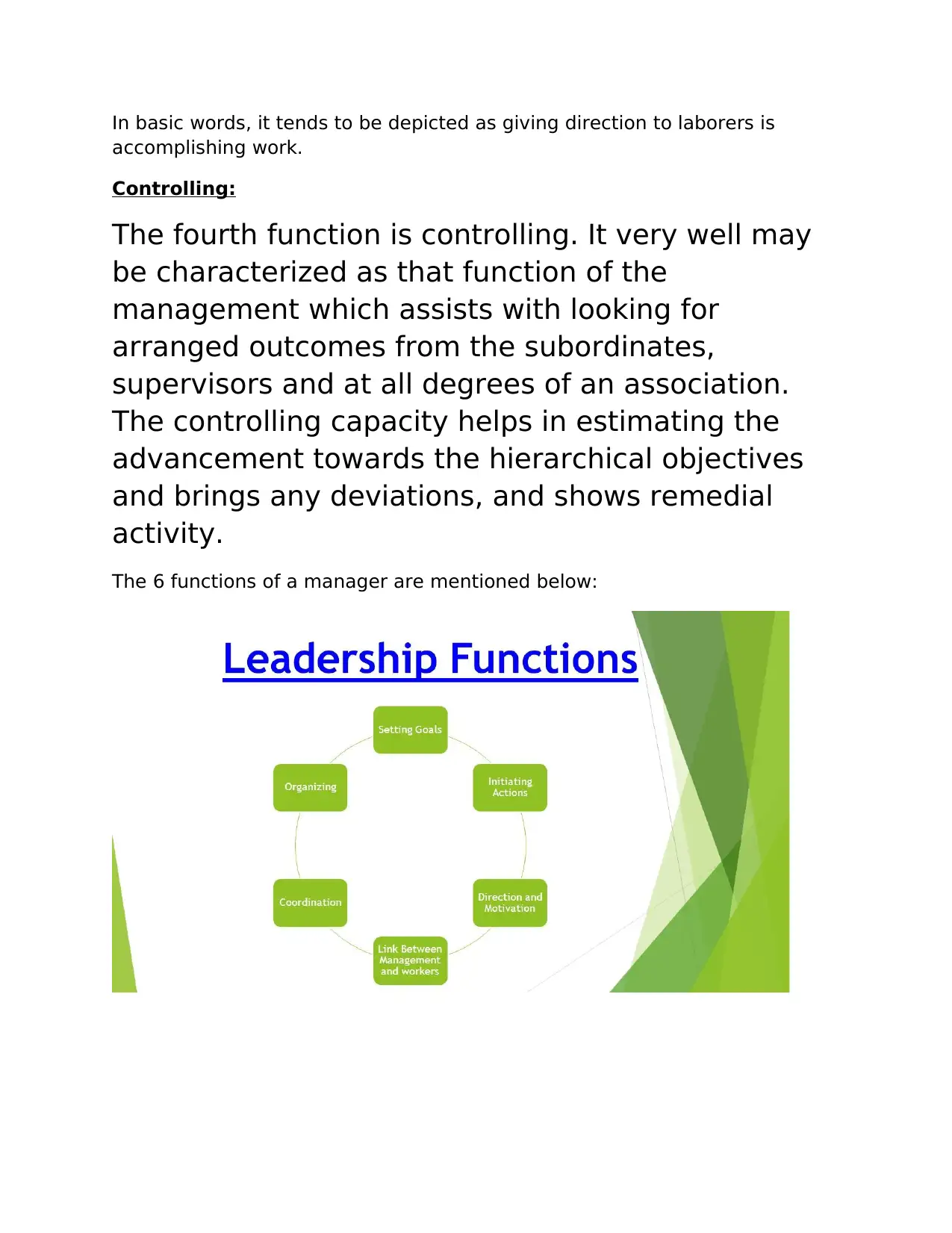
In basic words, it tends to be depicted as giving direction to laborers is
accomplishing work.
Controlling:
The fourth function is controlling. It very well may
be characterized as that function of the
management which assists with looking for
arranged outcomes from the subordinates,
supervisors and at all degrees of an association.
The controlling capacity helps in estimating the
advancement towards the hierarchical objectives
and brings any deviations, and shows remedial
activity.
The 6 functions of a manager are mentioned below:
accomplishing work.
Controlling:
The fourth function is controlling. It very well may
be characterized as that function of the
management which assists with looking for
arranged outcomes from the subordinates,
supervisors and at all degrees of an association.
The controlling capacity helps in estimating the
advancement towards the hierarchical objectives
and brings any deviations, and shows remedial
activity.
The 6 functions of a manager are mentioned below:
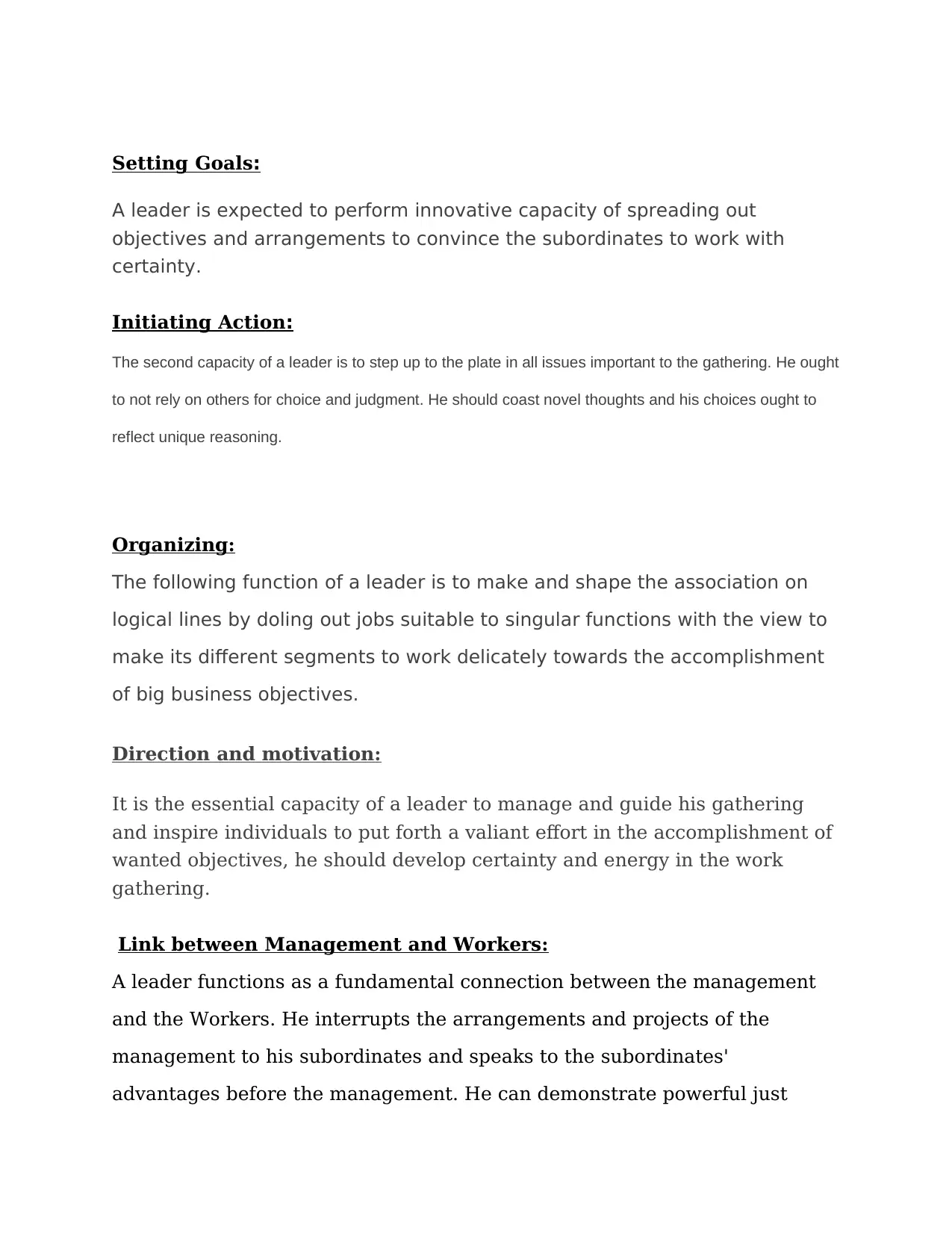
Setting Goals:
A leader is expected to perform innovative capacity of spreading out
objectives and arrangements to convince the subordinates to work with
certainty.
Initiating Action:
The second capacity of a leader is to step up to the plate in all issues important to the gathering. He ought
to not rely on others for choice and judgment. He should coast novel thoughts and his choices ought to
reflect unique reasoning.
Organizing:
The following function of a leader is to make and shape the association on
logical lines by doling out jobs suitable to singular functions with the view to
make its different segments to work delicately towards the accomplishment
of big business objectives.
Direction and motivation:
It is the essential capacity of a leader to manage and guide his gathering
and inspire individuals to put forth a valiant effort in the accomplishment of
wanted objectives, he should develop certainty and energy in the work
gathering.
Link between Management and Workers:
A leader functions as a fundamental connection between the management
and the Workers. He interrupts the arrangements and projects of the
management to his subordinates and speaks to the subordinates'
advantages before the management. He can demonstrate powerful just
A leader is expected to perform innovative capacity of spreading out
objectives and arrangements to convince the subordinates to work with
certainty.
Initiating Action:
The second capacity of a leader is to step up to the plate in all issues important to the gathering. He ought
to not rely on others for choice and judgment. He should coast novel thoughts and his choices ought to
reflect unique reasoning.
Organizing:
The following function of a leader is to make and shape the association on
logical lines by doling out jobs suitable to singular functions with the view to
make its different segments to work delicately towards the accomplishment
of big business objectives.
Direction and motivation:
It is the essential capacity of a leader to manage and guide his gathering
and inspire individuals to put forth a valiant effort in the accomplishment of
wanted objectives, he should develop certainty and energy in the work
gathering.
Link between Management and Workers:
A leader functions as a fundamental connection between the management
and the Workers. He interrupts the arrangements and projects of the
management to his subordinates and speaks to the subordinates'
advantages before the management. He can demonstrate powerful just
⊘ This is a preview!⊘
Do you want full access?
Subscribe today to unlock all pages.

Trusted by 1+ million students worldwide
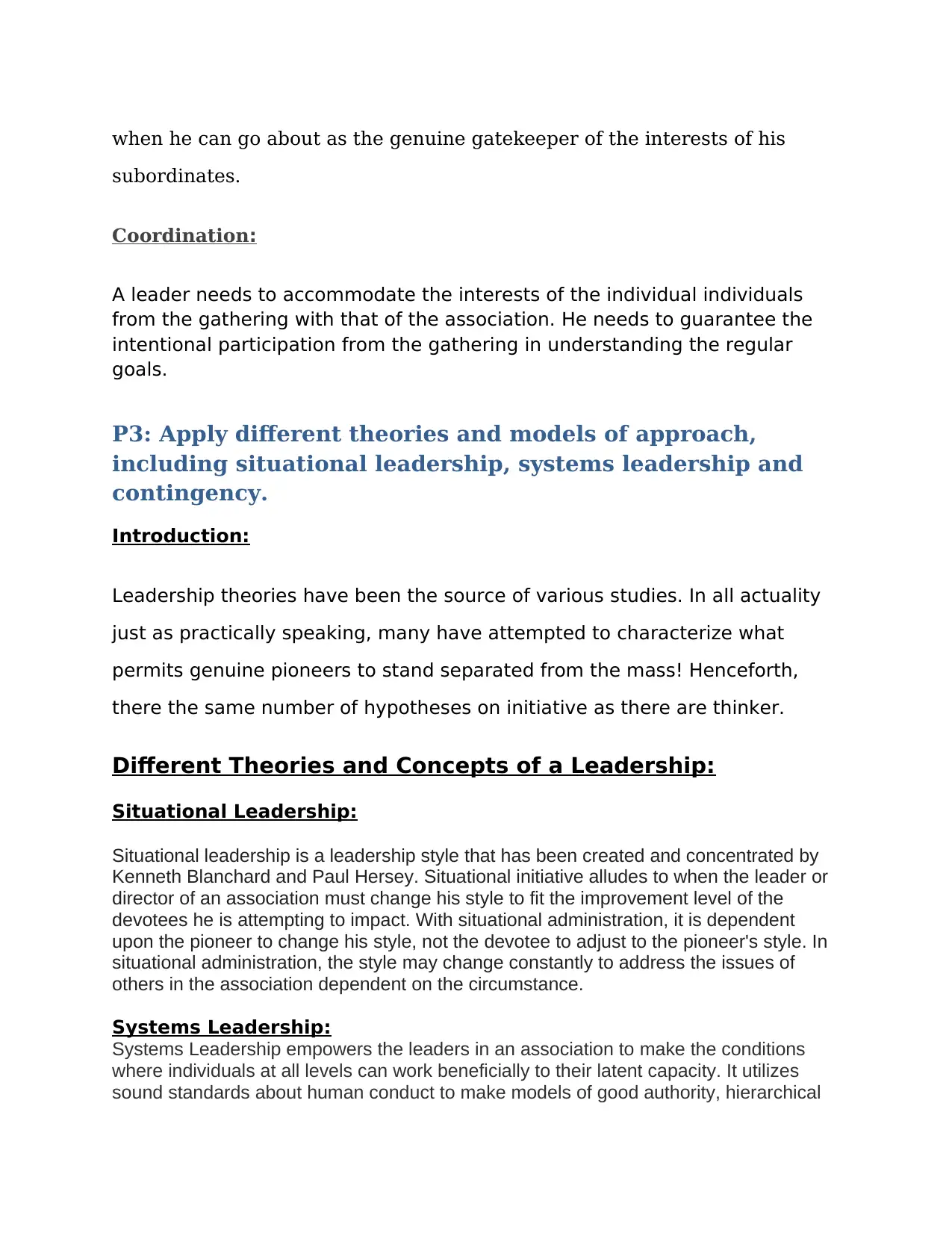
when he can go about as the genuine gatekeeper of the interests of his
subordinates.
Coordination:
A leader needs to accommodate the interests of the individual individuals
from the gathering with that of the association. He needs to guarantee the
intentional participation from the gathering in understanding the regular
goals.
P3: Apply different theories and models of approach,
including situational leadership, systems leadership and
contingency.
Introduction:
Leadership theories have been the source of various studies. In all actuality
just as practically speaking, many have attempted to characterize what
permits genuine pioneers to stand separated from the mass! Henceforth,
there the same number of hypotheses on initiative as there are thinker.
Different Theories and Concepts of a Leadership:
Situational Leadership:
Situational leadership is a leadership style that has been created and concentrated by
Kenneth Blanchard and Paul Hersey. Situational initiative alludes to when the leader or
director of an association must change his style to fit the improvement level of the
devotees he is attempting to impact. With situational administration, it is dependent
upon the pioneer to change his style, not the devotee to adjust to the pioneer's style. In
situational administration, the style may change constantly to address the issues of
others in the association dependent on the circumstance.
Systems Leadership:
Systems Leadership empowers the leaders in an association to make the conditions
where individuals at all levels can work beneficially to their latent capacity. It utilizes
sound standards about human conduct to make models of good authority, hierarchical
subordinates.
Coordination:
A leader needs to accommodate the interests of the individual individuals
from the gathering with that of the association. He needs to guarantee the
intentional participation from the gathering in understanding the regular
goals.
P3: Apply different theories and models of approach,
including situational leadership, systems leadership and
contingency.
Introduction:
Leadership theories have been the source of various studies. In all actuality
just as practically speaking, many have attempted to characterize what
permits genuine pioneers to stand separated from the mass! Henceforth,
there the same number of hypotheses on initiative as there are thinker.
Different Theories and Concepts of a Leadership:
Situational Leadership:
Situational leadership is a leadership style that has been created and concentrated by
Kenneth Blanchard and Paul Hersey. Situational initiative alludes to when the leader or
director of an association must change his style to fit the improvement level of the
devotees he is attempting to impact. With situational administration, it is dependent
upon the pioneer to change his style, not the devotee to adjust to the pioneer's style. In
situational administration, the style may change constantly to address the issues of
others in the association dependent on the circumstance.
Systems Leadership:
Systems Leadership empowers the leaders in an association to make the conditions
where individuals at all levels can work beneficially to their latent capacity. It utilizes
sound standards about human conduct to make models of good authority, hierarchical
Paraphrase This Document
Need a fresh take? Get an instant paraphrase of this document with our AI Paraphraser
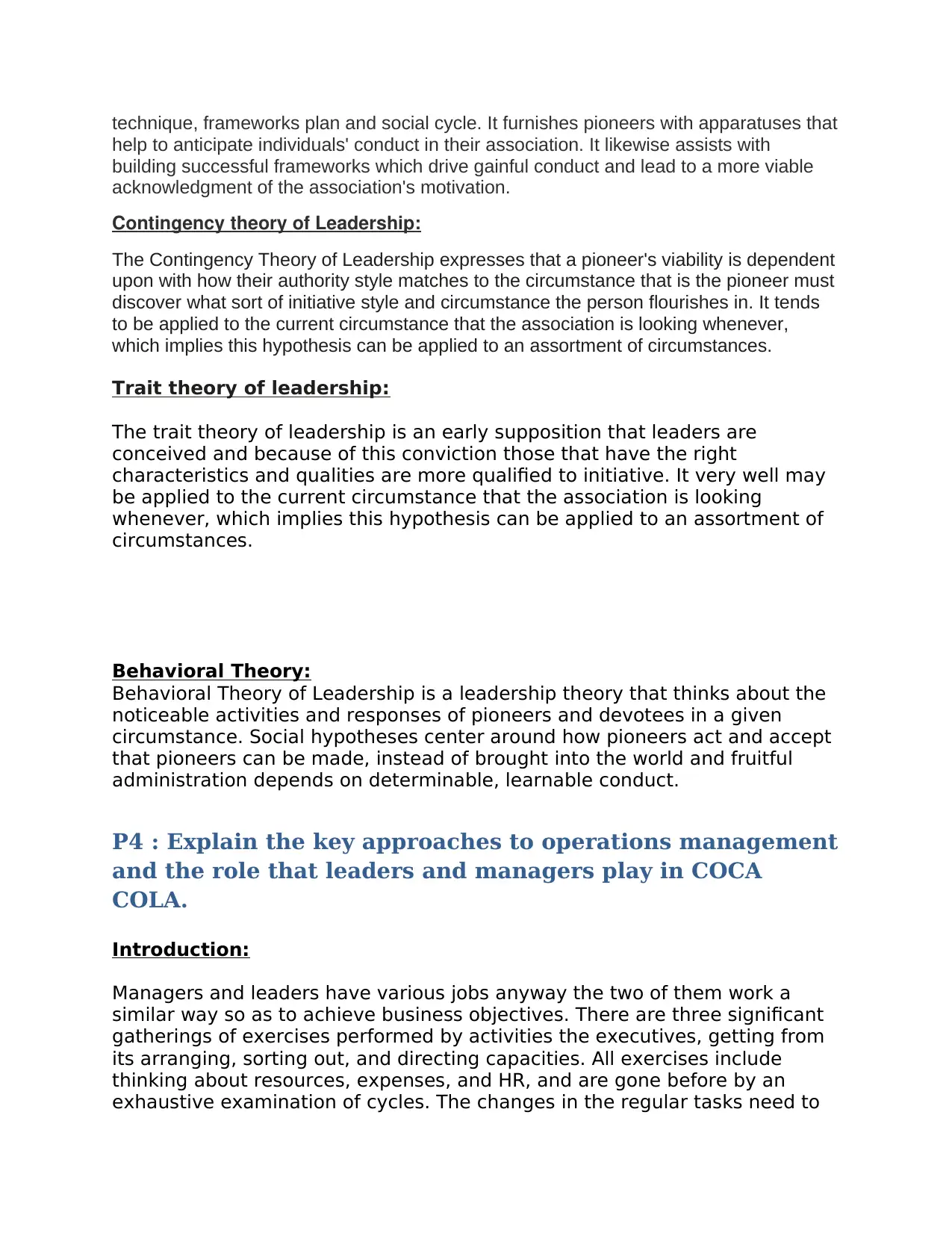
technique, frameworks plan and social cycle. It furnishes pioneers with apparatuses that
help to anticipate individuals' conduct in their association. It likewise assists with
building successful frameworks which drive gainful conduct and lead to a more viable
acknowledgment of the association's motivation.
Contingency theory of Leadership:
The Contingency Theory of Leadership expresses that a pioneer's viability is dependent
upon with how their authority style matches to the circumstance that is the pioneer must
discover what sort of initiative style and circumstance the person flourishes in. It tends
to be applied to the current circumstance that the association is looking whenever,
which implies this hypothesis can be applied to an assortment of circumstances.
Trait theory of leadership:
The trait theory of leadership is an early supposition that leaders are
conceived and because of this conviction those that have the right
characteristics and qualities are more qualified to initiative. It very well may
be applied to the current circumstance that the association is looking
whenever, which implies this hypothesis can be applied to an assortment of
circumstances.
Behavioral Theory:
Behavioral Theory of Leadership is a leadership theory that thinks about the
noticeable activities and responses of pioneers and devotees in a given
circumstance. Social hypotheses center around how pioneers act and accept
that pioneers can be made, instead of brought into the world and fruitful
administration depends on determinable, learnable conduct.
P4 : Explain the key approaches to operations management
and the role that leaders and managers play in COCA
COLA.
Introduction:
Managers and leaders have various jobs anyway the two of them work a
similar way so as to achieve business objectives. There are three significant
gatherings of exercises performed by activities the executives, getting from
its arranging, sorting out, and directing capacities. All exercises include
thinking about resources, expenses, and HR, and are gone before by an
exhaustive examination of cycles. The changes in the regular tasks need to
help to anticipate individuals' conduct in their association. It likewise assists with
building successful frameworks which drive gainful conduct and lead to a more viable
acknowledgment of the association's motivation.
Contingency theory of Leadership:
The Contingency Theory of Leadership expresses that a pioneer's viability is dependent
upon with how their authority style matches to the circumstance that is the pioneer must
discover what sort of initiative style and circumstance the person flourishes in. It tends
to be applied to the current circumstance that the association is looking whenever,
which implies this hypothesis can be applied to an assortment of circumstances.
Trait theory of leadership:
The trait theory of leadership is an early supposition that leaders are
conceived and because of this conviction those that have the right
characteristics and qualities are more qualified to initiative. It very well may
be applied to the current circumstance that the association is looking
whenever, which implies this hypothesis can be applied to an assortment of
circumstances.
Behavioral Theory:
Behavioral Theory of Leadership is a leadership theory that thinks about the
noticeable activities and responses of pioneers and devotees in a given
circumstance. Social hypotheses center around how pioneers act and accept
that pioneers can be made, instead of brought into the world and fruitful
administration depends on determinable, learnable conduct.
P4 : Explain the key approaches to operations management
and the role that leaders and managers play in COCA
COLA.
Introduction:
Managers and leaders have various jobs anyway the two of them work a
similar way so as to achieve business objectives. There are three significant
gatherings of exercises performed by activities the executives, getting from
its arranging, sorting out, and directing capacities. All exercises include
thinking about resources, expenses, and HR, and are gone before by an
exhaustive examination of cycles. The changes in the regular tasks need to
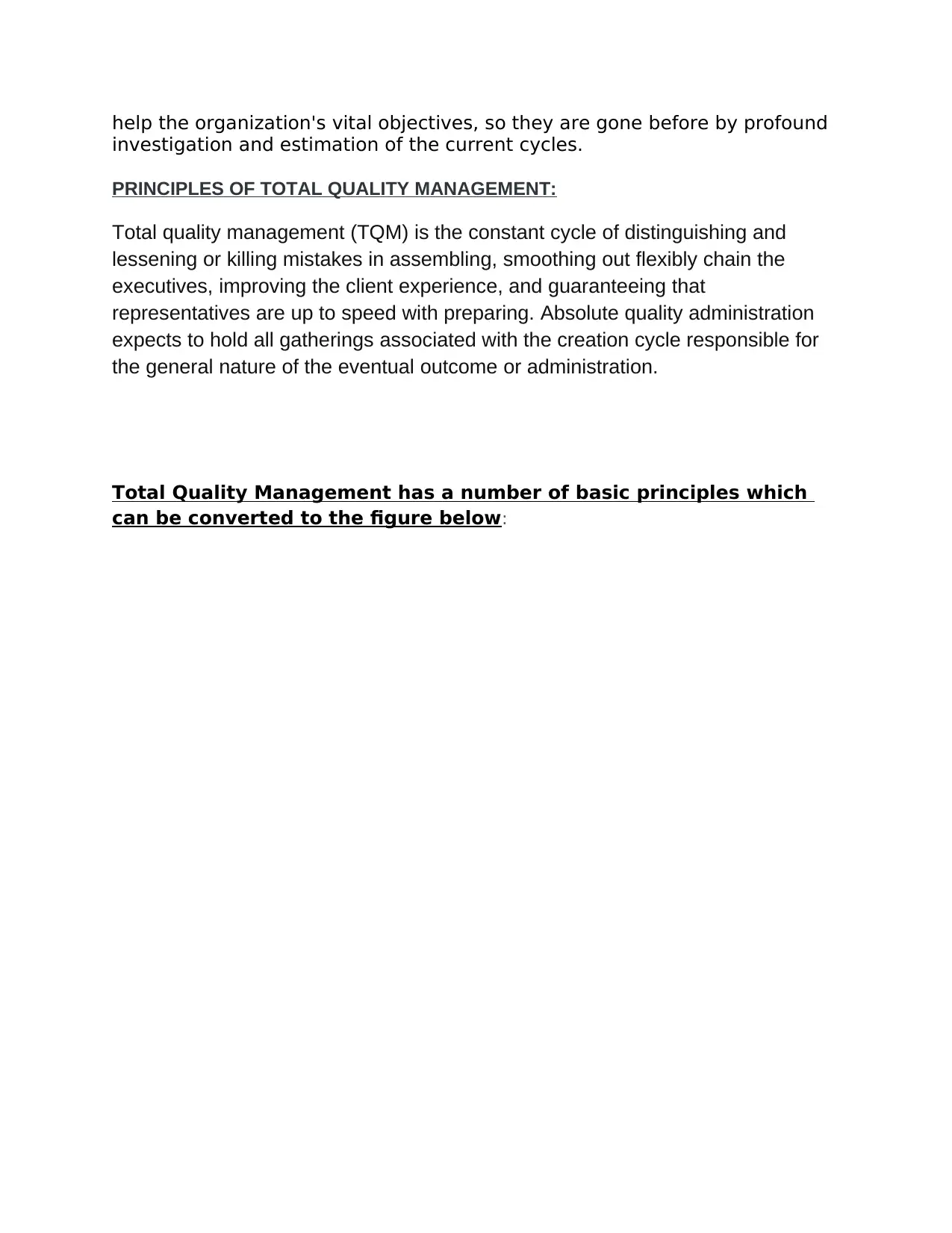
help the organization's vital objectives, so they are gone before by profound
investigation and estimation of the current cycles.
PRINCIPLES OF TOTAL QUALITY MANAGEMENT:
Total quality management (TQM) is the constant cycle of distinguishing and
lessening or killing mistakes in assembling, smoothing out flexibly chain the
executives, improving the client experience, and guaranteeing that
representatives are up to speed with preparing. Absolute quality administration
expects to hold all gatherings associated with the creation cycle responsible for
the general nature of the eventual outcome or administration.
Total Quality Management has a number of basic principles which
can be converted to the figure below:
investigation and estimation of the current cycles.
PRINCIPLES OF TOTAL QUALITY MANAGEMENT:
Total quality management (TQM) is the constant cycle of distinguishing and
lessening or killing mistakes in assembling, smoothing out flexibly chain the
executives, improving the client experience, and guaranteeing that
representatives are up to speed with preparing. Absolute quality administration
expects to hold all gatherings associated with the creation cycle responsible for
the general nature of the eventual outcome or administration.
Total Quality Management has a number of basic principles which
can be converted to the figure below:
⊘ This is a preview!⊘
Do you want full access?
Subscribe today to unlock all pages.

Trusted by 1+ million students worldwide
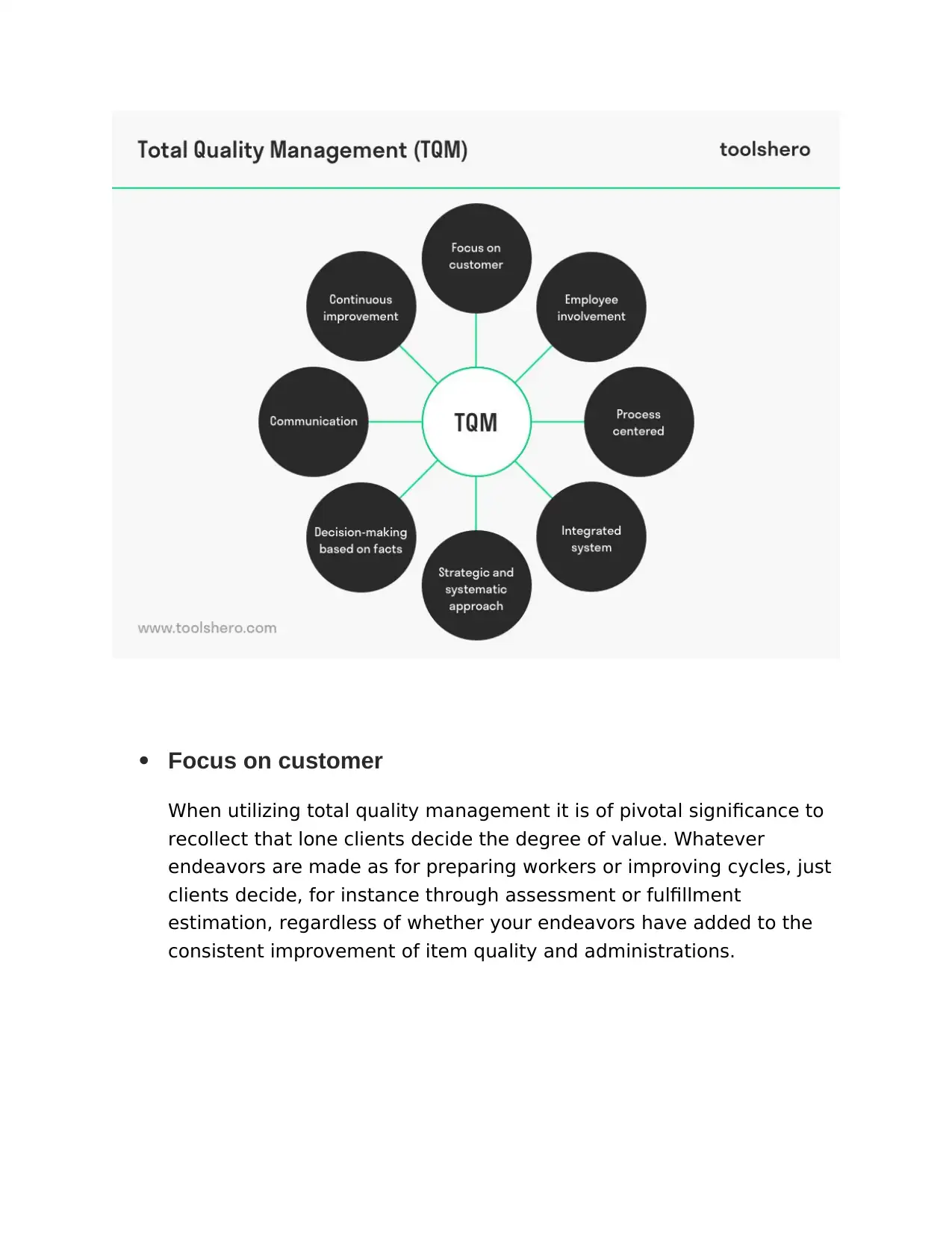
Focus on customer
When utilizing total quality management it is of pivotal significance to
recollect that lone clients decide the degree of value. Whatever
endeavors are made as for preparing workers or improving cycles, just
clients decide, for instance through assessment or fulfillment
estimation, regardless of whether your endeavors have added to the
consistent improvement of item quality and administrations.
When utilizing total quality management it is of pivotal significance to
recollect that lone clients decide the degree of value. Whatever
endeavors are made as for preparing workers or improving cycles, just
clients decide, for instance through assessment or fulfillment
estimation, regardless of whether your endeavors have added to the
consistent improvement of item quality and administrations.
Paraphrase This Document
Need a fresh take? Get an instant paraphrase of this document with our AI Paraphraser
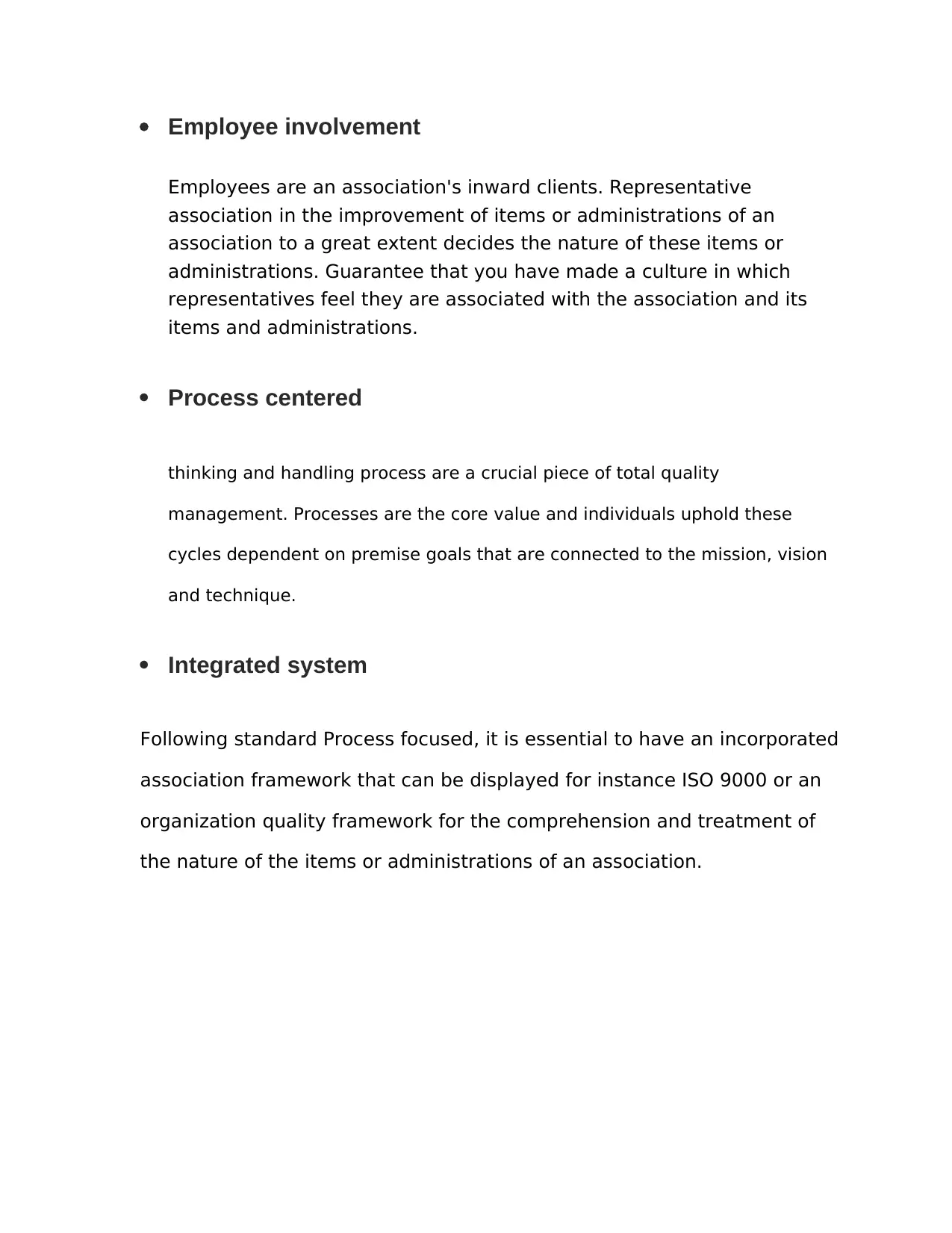
Employee involvement
Employees are an association's inward clients. Representative
association in the improvement of items or administrations of an
association to a great extent decides the nature of these items or
administrations. Guarantee that you have made a culture in which
representatives feel they are associated with the association and its
items and administrations.
Process centered
thinking and handling process are a crucial piece of total quality
management. Processes are the core value and individuals uphold these
cycles dependent on premise goals that are connected to the mission, vision
and technique.
Integrated system
Following standard Process focused, it is essential to have an incorporated
association framework that can be displayed for instance ISO 9000 or an
organization quality framework for the comprehension and treatment of
the nature of the items or administrations of an association.
Employees are an association's inward clients. Representative
association in the improvement of items or administrations of an
association to a great extent decides the nature of these items or
administrations. Guarantee that you have made a culture in which
representatives feel they are associated with the association and its
items and administrations.
Process centered
thinking and handling process are a crucial piece of total quality
management. Processes are the core value and individuals uphold these
cycles dependent on premise goals that are connected to the mission, vision
and technique.
Integrated system
Following standard Process focused, it is essential to have an incorporated
association framework that can be displayed for instance ISO 9000 or an
organization quality framework for the comprehension and treatment of
the nature of the items or administrations of an association.
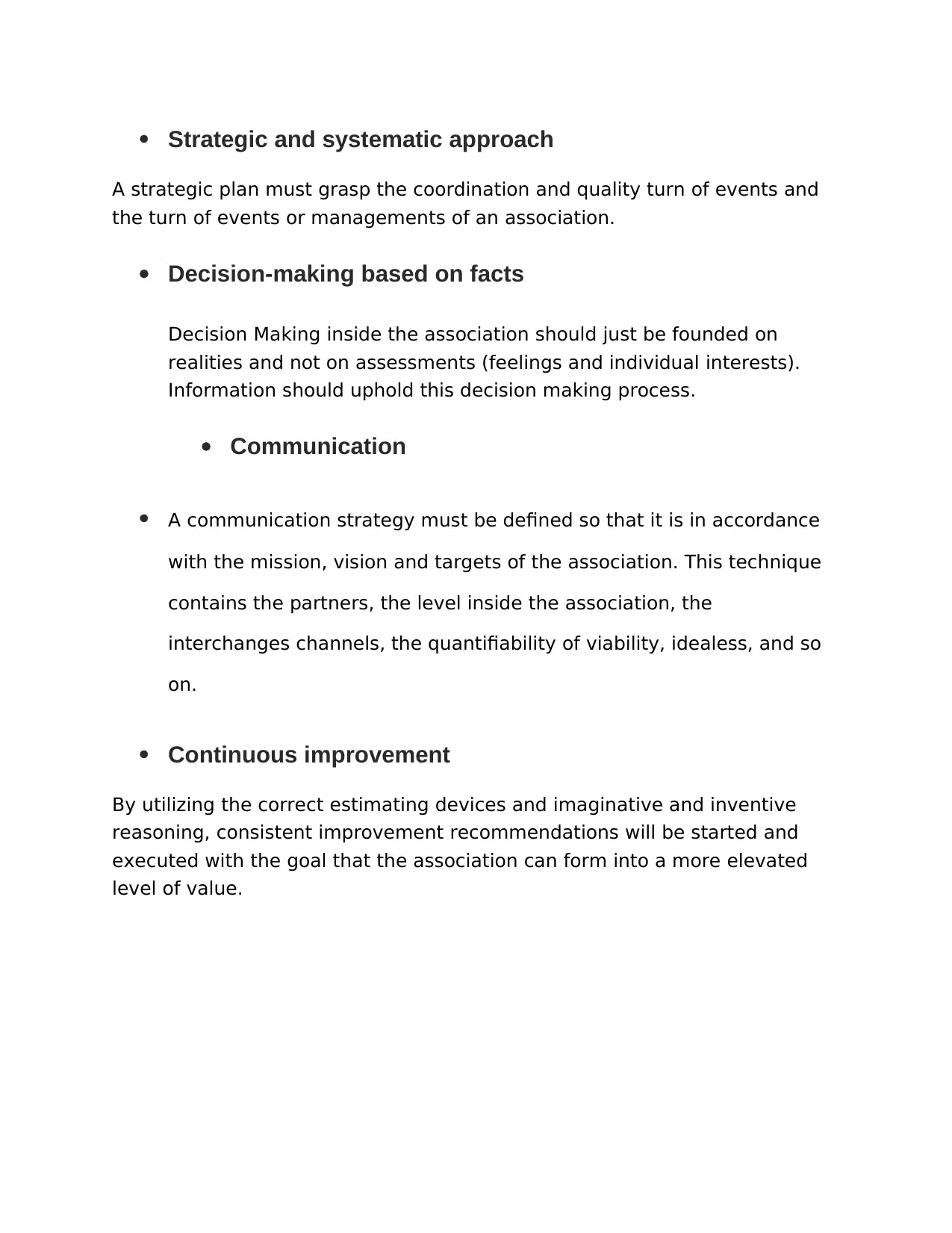
Strategic and systematic approach
A strategic plan must grasp the coordination and quality turn of events and
the turn of events or managements of an association.
Decision-making based on facts
Decision Making inside the association should just be founded on
realities and not on assessments (feelings and individual interests).
Information should uphold this decision making process.
Communication
A communication strategy must be defined so that it is in accordance
with the mission, vision and targets of the association. This technique
contains the partners, the level inside the association, the
interchanges channels, the quantifiability of viability, idealess, and so
on.
Continuous improvement
By utilizing the correct estimating devices and imaginative and inventive
reasoning, consistent improvement recommendations will be started and
executed with the goal that the association can form into a more elevated
level of value.
A strategic plan must grasp the coordination and quality turn of events and
the turn of events or managements of an association.
Decision-making based on facts
Decision Making inside the association should just be founded on
realities and not on assessments (feelings and individual interests).
Information should uphold this decision making process.
Communication
A communication strategy must be defined so that it is in accordance
with the mission, vision and targets of the association. This technique
contains the partners, the level inside the association, the
interchanges channels, the quantifiability of viability, idealess, and so
on.
Continuous improvement
By utilizing the correct estimating devices and imaginative and inventive
reasoning, consistent improvement recommendations will be started and
executed with the goal that the association can form into a more elevated
level of value.
⊘ This is a preview!⊘
Do you want full access?
Subscribe today to unlock all pages.

Trusted by 1+ million students worldwide
1 out of 19
Related Documents
Your All-in-One AI-Powered Toolkit for Academic Success.
+13062052269
info@desklib.com
Available 24*7 on WhatsApp / Email
![[object Object]](/_next/static/media/star-bottom.7253800d.svg)
Unlock your academic potential
Copyright © 2020–2025 A2Z Services. All Rights Reserved. Developed and managed by ZUCOL.





